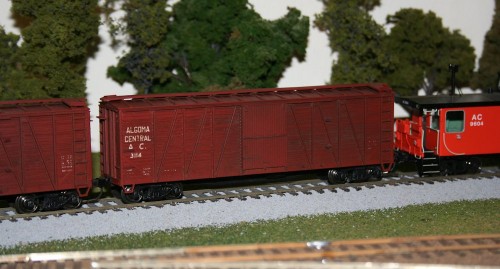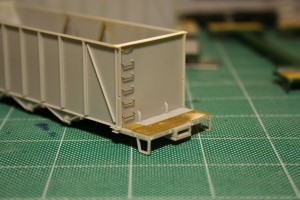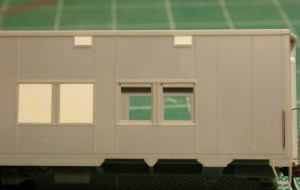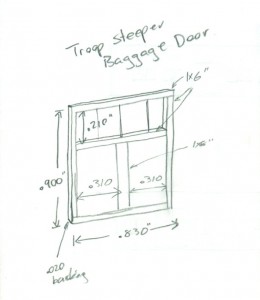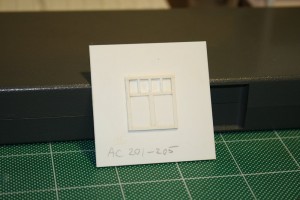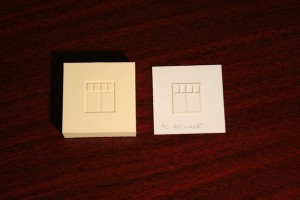Tonnage ratings are, put simply, a table of figures detailing the maximum tonnage a single locomotive of a particular type can handle across a railway or portion thereof. While certainly not the only consideration when applying power to a train (for example, in addition to tonnage ratings, some railroads may also specific a minimum horsepower per ton for specific trains, with priority fast freights given higher horsepower ratings to ensure quick movement), tonnage ratings are an important tool to make sure a train has at least the minimum amount of power (locomotives) to make it over the line.
Tonnage ratings are broken down by locomotive class (usually grouped by horsepower), and will vary on different portions of a railway based on ruling grades and curvature. The ratings are also listed separately in each direction over a portion of the railroad since uphill ruling grades will vary. For every class, there are three ratings listed, an A (best possible conditions), B and C (really miserable conditions like rain or ice making things really slippery) rating. The ratings are given on a per-unit basis; to know how much tonnage a particular consist can handle, you just add up the tonnage ratings for each unit for the overall rating.
Below are the actual ACR tonnage ratings copied from the 1982 summer employee’s timetable. It’s a bit of a dizzying wall of figures, and I’m not going to study the entire thing in detail, but the figures aren’t too difficult to interpret.
As a simple example, let’s say you have a 9000 ton train to haul from Hawk Junction to Hearst, and that conditions are good, so we’ll use the A rating. (We won’t worry about adding or dropping cars enroute.)
Looking at the table, we can see that a pair of SD40s will handle this nicely. (2units x 4620tons/unit = 9240)
However 2 GP38-2 units only have a combined tonnage rating of 6880, well under the 9000 tons we need to move, so we need a 3rd unit, which will bring the tonnage rating to 10320 if all three units are GP38-2s.
If all we have on hand are GP7s, 3 units at 2950tons/unit only gets us to 8850, so we’d need a fourth unit.
Of course we can mix and match units and just add up the tonnage ratings for each unit, the examples are just easier with similar units.
Table 1: ACR Tonnage Ratings from Timetable #139, May 29, 1982
|
GP7 |
GP9, GP38-2 |
SD40, SD40-2 |
|
A |
B |
C |
A |
B |
C |
A |
B |
C |
| Northward: |
| Steelton-Goulais |
1600 |
1490 |
1440 |
1865 |
1740 |
1680 |
2510 |
2330 |
2260 |
| Goulais-Frater |
1250 |
1160 |
1125 |
1460 |
1350 |
1310 |
1960 |
1825 |
1765 |
| Frater-Hawk |
1500 |
1395 |
1350 |
1750 |
1625 |
1575 |
2350 |
2185 |
2115 |
| Hawk-Hearst |
2950 |
2745 |
2655 |
3440 |
3200 |
3100 |
4620 |
4300 |
4160 |
| Southward: |
| Hearst-Hawk |
3100 |
2890 |
2790 |
3615 |
3370 |
3255 |
4800 |
4450 |
4320 |
| Hawk-Mekatina |
1400 |
1300 |
1260 |
1630 |
1515 |
1470 |
2170 |
2020 |
1955 |
| Mekatina-Goulais |
1550 |
1440 |
1395 |
1810 |
1680 |
1625 |
2400 |
2230 |
2160 |
| Goulais-Steelton |
1650 |
1535 |
1485 |
1925 |
1790 |
1730 |
2560 |
2380 |
2305 |
| Westward: |
| Hawk-Siderite |
1350 |
1255 |
1215 |
1575 |
1465 |
1415 |
2120 |
1970 |
1910 |
| Siderite-Brient |
1800 |
1675 |
1620 |
2100 |
1955 |
1890 |
2820 |
2620 |
2540 |
| Eastward: |
| Brient-Helen |
1000 |
930 |
900 |
1165 |
1085 |
1050 |
1550 |
1440 |
1395 |
| Helen-Hawk |
1430 |
1330 |
1285 |
1670 |
1550 |
1500 |
2220 |
2065 |
2000 |
There are two things I’d like to draw your attention to in the table.
- Note the extremely low numbers eastward out of Brient (Brient was the yard that served the harbour at Michipicoten, at the terminus of the Michipicoten branch), barely better than half of the westward ratings for the same portion. From the harbour at Michipicoten to Wawa is an almost continuous upgrade, and the steepest grades on the railroad are found near Brient on the descent to the Lake Superior shoreline, reaching 4% between the former Brient yard and Michipicoten.
- Note also the huge disparity between the tonnage ratings north of Hawk Junction and the rest of the railway. North of Hawk Junction, and away from Lake Superior, the terrain flattens out considerably, and this is clearly reflecting in the more favourable tonnage ratings.
So where do we go from here?
The first thing is that these are tonnage (weight) ratings, not car counts. Unless your passion is number crunching, something that uses a simple car count instead of adding up differing tonnages for each car is probably a much preferable system for determining engines to train length.
The other issue is that on the model railroad, we try to weight our cars consistently so they operate well on our tighter-than prototypical curves and generally steeper than average grades (especially helices). There’s really not much of a difference between the weight of a load or empty.
While there have been articles published about methods scaling down prototype weights for the extra realism, and manipulating this table is actually kind of fun as an academic exercise, during an operating session I would prefer a quick an simple way of just looking at the train length to determine how many engines are required.
The simplest thing to do on a model railroad would be to take a representative unit, stick a bunch of cars behind it and run it up the ruling grade on the layout (quite likely the helix if your layout has one.) Find out how many cars a single unit can pull and use that as a baseline to say you can have, for example, up to ten cars per engine on a train. If your layout is flat, or your grades are very gentle, you might arbitrarily set your car counts to have something that looks good (or just not worry about it too much, and just say, “Yeah, that looks about right for this layout” – although really that’s pretty much the same thing, just without writing down an actual “rule” for it.) There’s not really a wrong way of doing it, as long as the engines can handle the size of the train.
Finally, model locomotives tend to be a lot more equivalent; a model SD40-2 isn’t twice as powerful as a model GP7; more likely they’re pretty equivalent. Depending on the brands or makes of the models, the GP7 could even be a better puller than the SD40! So to make the SD40s look more powerful, we institute an artificial restriction on the GP7s, maybe something as simple as “10 cars per 6-axle unit, 8 cars per 4-axle unit” to force the use of more smaller units to replace a pair of bigger ones, instead of having 2 GP7s do the same work as 2 SD40s.
The interesting thing about the ACR tonnage ratings is that huge disparity mentioned above between the flatter Northern subdivision north of Hawk Junction and the rest of the railway, which stays much closer to the rocky shores of Lake Superior. However, when I get to the point of actually building my ACR layout, which will be based on the Northern and Michipicoten subdivisions, I don’t imagine that grades on the (model) Northern sub. will be appreciably different than on the Michipicoten branch. In fact, depending on the layout design and inclusions of helices to double deck the layout or lengthen the run between stations, the ruling mainline grades could actually be between Hawk Junction and Hearst.
However the prototype tonnage ratings show that trains leaving Hawk Junction to the north should have a higher power/car ratio than trains heading south to Steelton (Sault Ste. Marie) or Wawa/Michipicoten. While the model version won’t really have the same characteristics, I can fake by decreeing artificially lower car counts/engine for the Michipicoten and Soo subdivisions. The last will likely just be staging, but trains leaving the modelled yard at Hawk Junction should “look right.”
As an exercise, I took the “A” rating column* for each class and divided the all the numbers by 125 tons. 125 tons is the approximate gross weight of a fully loaded 100 ton capacity car (like the ACR’s 100-ton open hoppers). But except for (loaded) ore trains, the average car in the 1980s was more like 70-ton capacity, and of course empties are much lighter. So this has the quite deliberate effect of already forcing car counts down.
* Since I probably won’t be modelling much of the Soo subdivision south of Hawk Junction, I only included north of Frater, and to simplify the Michipicoten branch, I split it at Wawa instead of Siderite, since Wawa and Michipicoten will probably be the only actually modelled locations on the branch.
The interesting thing about dividing by 125 (the weight of a loaded ore car) is that on the Michipicoten branch in the 1980s, the traffic was pretty much all loaded hoppers eastward, empties westward; so this actually gives a pretty good picture of the power required for loaded ore trains; 3 SD40s or 5 GP7s for a 36-car train of loaded hoppers. The westward car counts could actually be much higher since the cars would all be empties, but you also have to provide enough power to account for bringing the loaded train back!
After dividing by 125, I multiplied everything by .6 (somewhat less than 2/3) to scale things down a bit more, and simply rounded everything off to whole numbers. This already produces some interesting results, but some numbers are a bit high yet and may need to be artificially downgraded yet, but it’s an interesting place to start. Let’s take a look:
Table 2: “A” ratings, divided by 125tons and scaled down by .6
|
GP7 |
GP9, GP38-2 |
SD40, SD40-2 |
| Northward: |
| Frater-Hawk |
7 |
8 |
11 |
| Hawk-Hearst |
14 |
17 |
22 |
| Southward: |
| Hearst-Hawk |
14 |
17 |
23 |
| Hawk-Frater |
7 |
8 |
10 |
| Westward: |
| Hawk-Wawa |
6 |
8 |
10 |
| Wawa-Michipicoten |
9 |
10 |
14 |
| Eastward: |
| Michipicoten-Wawa |
5 |
6 |
7 |
| Wawa-Hawk |
7 |
8 |
11 |
This does some interesting things, which are easier to see with the smaller set of smaller numbers. The counts for the portion from Hawk Junction to Hearst are almost exactly double everything else, and things are pretty consistent in both directions, except between Wawa and Michipicoten where some really interesting things happen. Remember it’s basically entirely uphill from Michipicoten to Wawa.
Those Hawk-Hearst numbers remain pretty high, and now it’s really clear how much easier the north end of the railway is compared to the south. I don’t think a single model SD40 will handle 23 cars up a helix! I’ll need to limit things more on the Northern sub, so my ratios are never going to be quite double like the numbers above.
Here’s what happens when I scale everything a factor of one half, instead of .6:
Table 2: “A” ratings, divided by 125tons and scaled down by .5
|
GP7 |
GP9, GP38-2 |
SD40, SD40-2 |
| Northward: |
| Frater-Hawk |
6 |
7 |
9 |
| Hawk-Hearst |
12 |
14 |
18 |
| Southward: |
| Hearst-Hawk |
12 |
14 |
19 |
| Hawk-Frater |
6 |
7 |
9 |
| Westward: |
| Hawk-Wawa |
5 |
6 |
8 |
| Wawa-Michipicoten |
7 |
8 |
11 |
| Eastward: |
| Michipicoten-Wawa |
4 |
5 |
6 |
| Wawa-Hawk |
6 |
7 |
9 |
That produces something interesting. Just reading numbers off of this and using the same car counts in both directions pretty much gives max car counts of 12/14/18 (for GP7/GP38/SD40 respectively) between Hawk Junction and Hearst, and 6/7/9 everywhere else except for the extreme restrictions on the grade out of Michipicoten. But even that’s pretty reasonable: 3 SD40s handling a max of 18 cars (include the caboose in that) which is a decent sized train on a model railroad and would look pretty spiffy.
The Hawk-Hearst numbers will need to be scaled down more based on the realities of model locomotive performance, but the rest looks pretty reasonable, at least on paper.
Will I adopt these car limits as-is? Ultimately probably not exactly, but it’s an interesting place to start and hopefully something to generate some good discussion!


